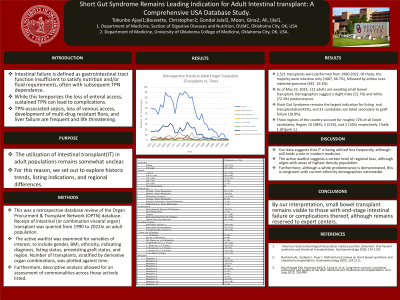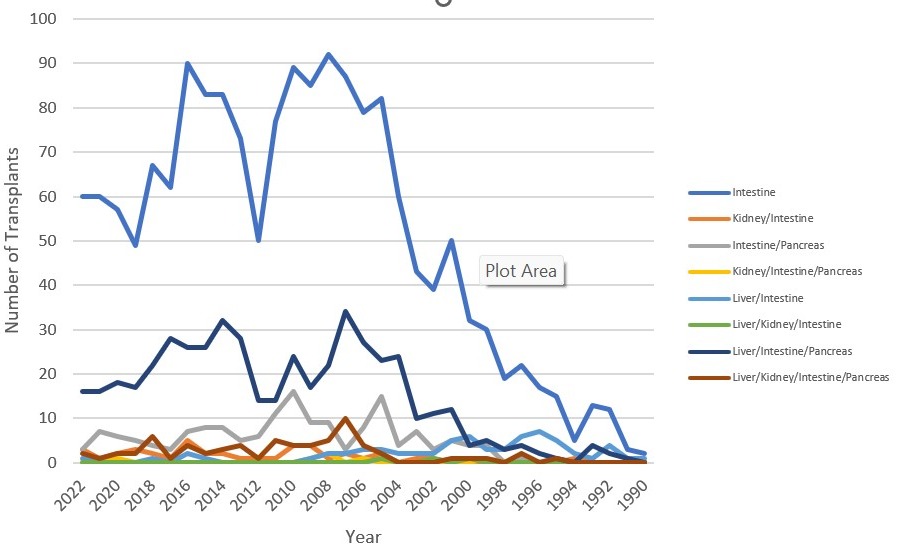Tuesday Poster Session
Category: Small Intestine
P4110 - Short Gut Syndrome Remains Leading Indication for Adult Intestinal Transplant: A Comprehensive USA Database Study
Tuesday, October 24, 2023
10:30 AM - 4:00 PM PT
Location: Exhibit Hall

Has Audio
- TA
Tokunbo Ajayi, MD
University of Oklahoma College of Medicine
Oklahoma City, OK
Presenting Author(s)
Tokunbo Ajayi, MD1, Christopher Bouvette, MD2, Gina Moon, MD3, Gondal Jalal, BA2, Ijlal Ali, MD2
1University of Oklahoma College of Medicine, Oklahoma City, OK; 2University of Oklahoma Health Sciences Center, Oklahoma City, OK; 3Oklahoma University Health Sciences Center, Oklahoma City, OK
Introduction: Intestinal failure is defined as gastrointestinal tract function insufficient to satisfy nutrition and/or fluid requirements, often with subsequent TPN dependance. While this temporizes the loss of enteral access, sustained TPN can bear complications. TPN-associated sepsis, loss of venous access, development of multi-drug resistant flora, and liver failure are frequent and life threatening. The utilization of small bowel transplant in adult populations remains somewhat unclear. For this reason, we set out to explore historic trends, indications, and implementation.
Methods: This was a retrospective database review of the Organ Procurment & Transplant Network (OPTN) database. Receipt of intestinal (or combination visceral organ) transplant was queried by year for 1990 to 2022, and recipients were selected by age to define an adult population. Furthermore, the active waitlist was examined for variables of interest, to include: gender, BMI, ethnicity, indicating diagnosis, listing status, preexisting graft status, and region. Number of transplants, stratified by derivative organ combinations, was plotted against time. Furthermore, descriptive analysis allowed for an assessment of commonalities across those actively listed.
Results: 2,521 transplants were performed from 1990-2022. Of these, the majority were intestine only (1687,66.7%). This is followed by enbloc liver-intestine-pancreas (487,19.3%). As of May 25, 2023, 112 adults are awaiting small bowel transplant. Demographics suggest a slight male (52.7%) and white (72.3%) predominance. Short Gut Syndrome remains the largest indication for listing (42%), and 21 candidates are listed secondary to graft failure (18.8%). Three regions of the country account for roughly 72% of all listed candidates; Region 10 (38%),5(21%) and 2(14%) respectively.(Table 1)(Figure 1)
Discussion: Our data suggests that small bowel transplant is being utilized less frequently, although still holds a role in modern medicine. The active waitlist suggests a certain level of regional bias, although aligns with areas of highest density population. Furthermore, although a white predominance is demonstrated, this is congruent with current ethnicity demographics nationwide. By our interpretation, small bowel transplant remains viable to those with end-stage intestinal failure or complications thereof, although remains reserved to expert centers.

Disclosures:
Tokunbo Ajayi, MD1, Christopher Bouvette, MD2, Gina Moon, MD3, Gondal Jalal, BA2, Ijlal Ali, MD2. P4110 - Short Gut Syndrome Remains Leading Indication for Adult Intestinal Transplant: A Comprehensive USA Database Study, ACG 2023 Annual Scientific Meeting Abstracts. Vancouver, BC, Canada: American College of Gastroenterology.
1University of Oklahoma College of Medicine, Oklahoma City, OK; 2University of Oklahoma Health Sciences Center, Oklahoma City, OK; 3Oklahoma University Health Sciences Center, Oklahoma City, OK
Introduction: Intestinal failure is defined as gastrointestinal tract function insufficient to satisfy nutrition and/or fluid requirements, often with subsequent TPN dependance. While this temporizes the loss of enteral access, sustained TPN can bear complications. TPN-associated sepsis, loss of venous access, development of multi-drug resistant flora, and liver failure are frequent and life threatening. The utilization of small bowel transplant in adult populations remains somewhat unclear. For this reason, we set out to explore historic trends, indications, and implementation.
Methods: This was a retrospective database review of the Organ Procurment & Transplant Network (OPTN) database. Receipt of intestinal (or combination visceral organ) transplant was queried by year for 1990 to 2022, and recipients were selected by age to define an adult population. Furthermore, the active waitlist was examined for variables of interest, to include: gender, BMI, ethnicity, indicating diagnosis, listing status, preexisting graft status, and region. Number of transplants, stratified by derivative organ combinations, was plotted against time. Furthermore, descriptive analysis allowed for an assessment of commonalities across those actively listed.
Results: 2,521 transplants were performed from 1990-2022. Of these, the majority were intestine only (1687,66.7%). This is followed by enbloc liver-intestine-pancreas (487,19.3%). As of May 25, 2023, 112 adults are awaiting small bowel transplant. Demographics suggest a slight male (52.7%) and white (72.3%) predominance. Short Gut Syndrome remains the largest indication for listing (42%), and 21 candidates are listed secondary to graft failure (18.8%). Three regions of the country account for roughly 72% of all listed candidates; Region 10 (38%),5(21%) and 2(14%) respectively.(Table 1)(Figure 1)
Discussion: Our data suggests that small bowel transplant is being utilized less frequently, although still holds a role in modern medicine. The active waitlist suggests a certain level of regional bias, although aligns with areas of highest density population. Furthermore, although a white predominance is demonstrated, this is congruent with current ethnicity demographics nationwide. By our interpretation, small bowel transplant remains viable to those with end-stage intestinal failure or complications thereof, although remains reserved to expert centers.

Figure: Retrospective Trends in Adult Forgut Transplant (Transplants vs. Time)
Disclosures:
Tokunbo Ajayi indicated no relevant financial relationships.
Christopher Bouvette indicated no relevant financial relationships.
Gina Moon indicated no relevant financial relationships.
Gondal Jalal indicated no relevant financial relationships.
Ijlal Ali indicated no relevant financial relationships.
Tokunbo Ajayi, MD1, Christopher Bouvette, MD2, Gina Moon, MD3, Gondal Jalal, BA2, Ijlal Ali, MD2. P4110 - Short Gut Syndrome Remains Leading Indication for Adult Intestinal Transplant: A Comprehensive USA Database Study, ACG 2023 Annual Scientific Meeting Abstracts. Vancouver, BC, Canada: American College of Gastroenterology.
